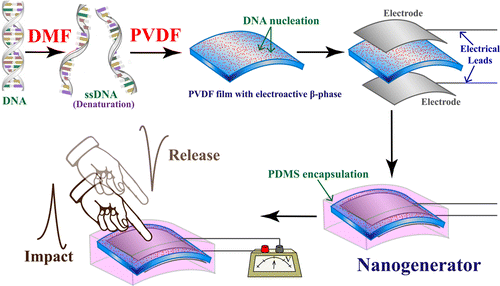Flexible, biodegradable device can generate power from touch

Long-standing concerns about portable electronics include the devices' short battery life and their contribution to e-waste. One group of scientists is now working on a way to address both of these seeming unrelated issues at the same time. They report in the journal ACS Applied Materials & Interfaces the development of a biodegradable nanogenerator made with DNA that can harvest the energy from everyday motion and turn it into electrical power.
Many people may not realize it, but the movements we often take for granted—such as walking and tapping on our keyboards—release energy that largely dissipates, unused. Several years ago, scientists figured out how to capture some of that energy and convert it into electricity so we might one day use it to power our mobile gadgetry. Achieving this would not only untether us from wall outlets, but it would also reduce our demand on fossil-fuel-based power sources. The first prototypes of these nanogenerators are currently being developed in laboratories around the world. And now, one group of scientists wants to add another feature to this technology: biodegradability.
The researchers built a nanogenerator using a flexible, biocompatible polymer film made out of polyvinylidene fluoride, or PVDF. To improve the material's energy-harvesting ability, they added DNA, which has good electrical properties and is biocompatible and biodegradable. Their device was powered with gentle tapping, and it lit up 22 to 55 light-emitting diodes.
More information: DNA-Assisted ß-phase Nucleation and Alignment of Molecular Dipoles in PVDF Film: A Realization of Self-Poled Bioinspired Flexible Polymer Nanogenerator for Portable Electronic Devices, ACS Appl. Mater. Interfaces, 2015, 7 (30), pp 16143–16147. DOI: 10.1021/acsami.5b04161
Abstract
A flexible nanogenerator (NG) is fabricated with a poly(vinylidene fluoride) (PVDF) film, where deoxyribonucleic acid (DNA) is the agent for the electroactive β-phase nucleation. Denatured DNA is co-operating to align the molecular −CH2/–CF2 dipoles of PVDF causing piezoelectricity without electrical poling. The NG is capable of harvesting energy from a variety of easily accessible mechanical stress such as human touch, machine vibration, football juggling, and walking. The NG exhibits high piezoelectric energy conversion efficiency facilitating the instant turn-on of several green or blue light-emitting diodes. The generated energy can be used to charge capacitors providing a wide scope for the design of self-powered portable devices.
Journal information: ACS Applied Materials and Interfaces
Provided by American Chemical Society




















